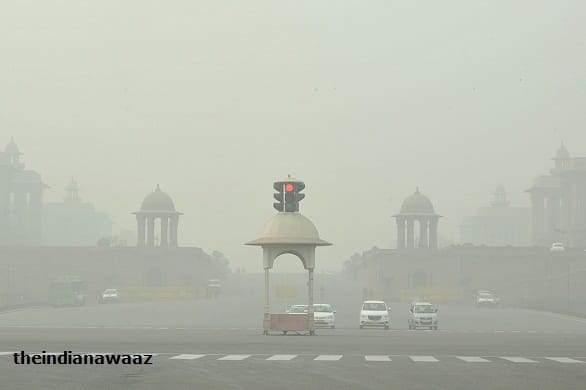According to India Meteorological Department, the air quality is likely to be in very poor category tomorrow. An Air Quality Index between 201 and 300 is considered poor, 301 to 400 very poor and 401 to 500 severe.

AMN / WEB DESK
A thick toxic haze or ‘smog’ returned to Delhi, Noida, Gurugram and surrounding places today (Monday) morning, as people people burst crackers on Diwali night, violating the Supreme Court’s ban order, leading to heavy pollution all across the National Capital Region – which has been already battling with its deteriorating air quality.
Visuals from across Delhi showed thick haze covering the roads, significantly reducing visibility and making it difficult to see beyond a few hundred metres.
As the AQI worsened in Delhi, ahead of Diwali, the Supreme Court had clarified that its order banning the use of barium and banned chemicals in firecrackers are applicable not just to the NCR but to the entire country.
- According to the Central Pollution Control Board (CPCB), while the average AQI remained very poor (312) in Anand Vihar at 8am on Monday, PM2.5 levels touched 488. Similarly, RK Puram saw an AQI of 305 at 8am, with PM2.5 being the most prominent pollutant touching 455. The concentration of PM 2.5 in the city has been recorded at 20 times the limit prescribed by the World Health Organisation, prompting the city government to order the closure of all primary classes and restrict the entry of trucks.
- At 5.30am, air quality levels in Delhi were at 514, higher than 320 on the air quality index – a level categorised as “hazardous” by Swiss group IQAir. According to IQAir, Delhi is the most polluted city in the world on Monday.
- Delhi’s Anand Vihar region registered the highest level of air pollution, with the air quality index (AQI) reaching 969 (hazardous) at 5am, according to weather agency aqicn.org. AQI between 0-50 is considered healthy, while a value over 300 represents ‘hazardous’ air quality.
- There are six categories of AQI – ‘good’ (0-50), ‘satisfactory’ (50-100), ‘moderately polluted’ (100-200), ‘poor’ (200-300), ‘very poor’ (300-400), and ‘severe’ (400-500).
- In Noida, the CPCB data showed AQI clocked at 269 (poor) at sector-62. But PM2.5 levels touched 500-mark.
- Gurugram’s AQI was 329 (very poor), while PM2.5 levels were nearly 500.
- Several people across NCR were seen gathering at the locality park for bursting crackers. The intensity of bursting firecrackers increased after 4pm, but it was comparatively lesser than last year.
- The AQI at many places peaked in the ‘severe’ category and continued to remain toxic for several days, but after Diwali, it is now very likely that the national capital will once again witness a rise in pollution levels, making it difficult for the people inside the city to breathe.
- Arvind Kejriwal-led AAP government in Delhi has imposed a complete ban on firecrackers. In the wake of the pollution situation, the government even considered the idea of ‘artificial rain’ to tackle the foul air in the city, until sudden rainfall brought a major respite, lowering the pollution level.
- Saturday’s 24-hour average air quality index stood at 220, the lowest for the day before Diwali in eight years.
- Thursday’s 24-hour average AQI stood at 437.
- Delhi recorded an AQI of 312 on Diwali last year, 382 in 2021, 414 in 2020, 337 in 2019, 281 in 2018, 319 in 2017, and 431 in 2016, the CPCB data showed.
